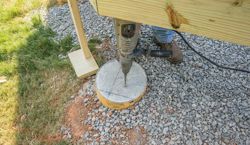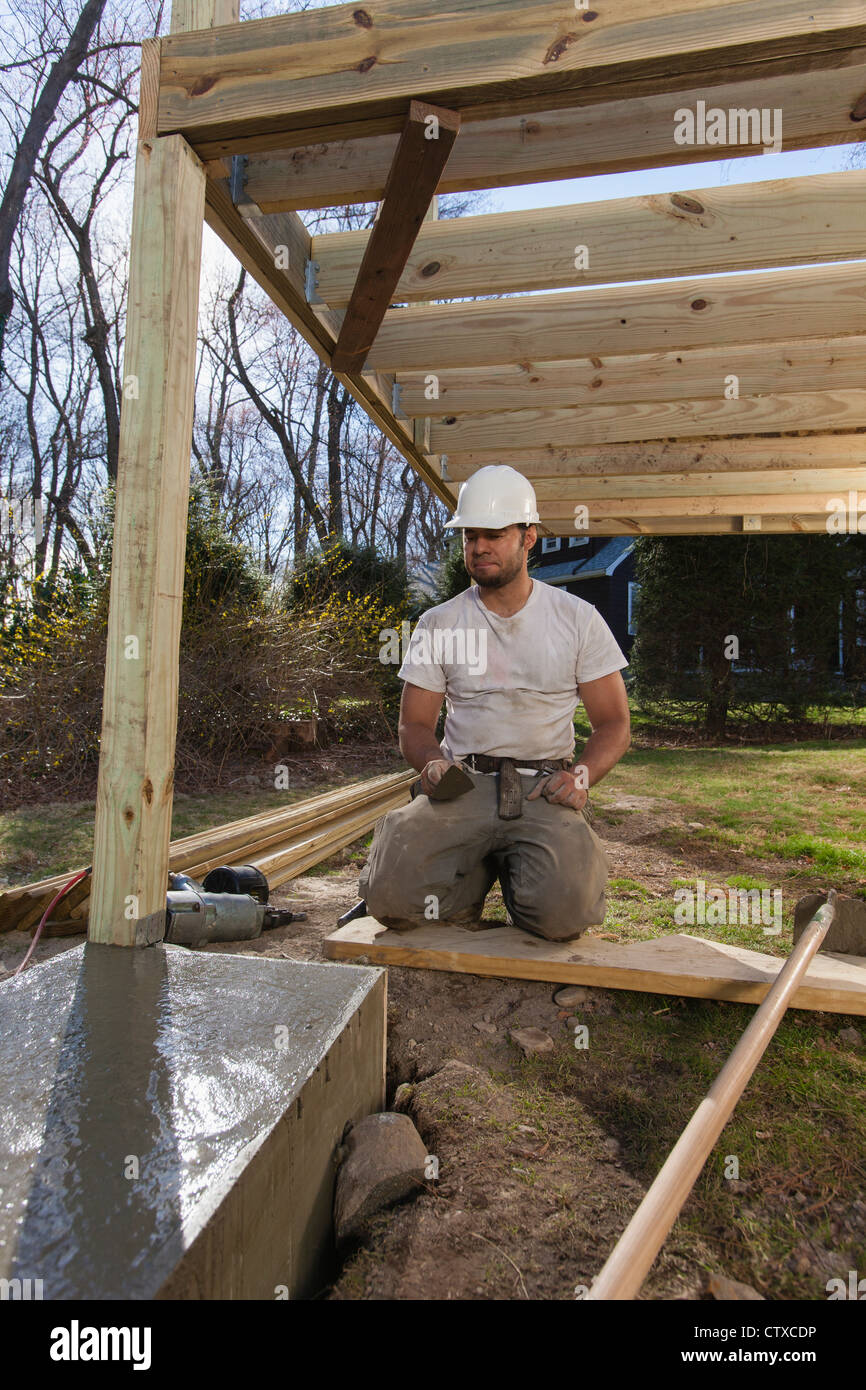From Concept to Concrete: The Essential Role of Deck Footings in Sturdy and Safe Decks
Wiki Article
Specialist Tips for Installing Deck Footings to Support Your Outdoor Area
When it comes to constructing a deck, one of the most important aspects to take into consideration is the setup of correct footings. These grounds are the structure upon which your exterior room will relax, providing stability and assistance for years to come. What precisely does it take to mount deck footings correctly?Value of Appropriate Deck Grounds
Correct deck grounds are vital for guaranteeing the security and durability of your exterior room. When building a deck, it is essential to take notice of the foundation on which it will relax. Deck footings give the necessary assistance for the entire framework and aid distribute the weight evenly - Deck Footings. Without solid and properly mounted footings, your deck might become unpredictable, bring about safety and security risks and expensive fixings.
Along with security, appropriate deck grounds also add to the long life of your outside area (Deck Footings). Grounds that are developed and created to withstand the components and soil problems in your location will certainly assist prevent the deck from resolving or moving in time. By guaranteeing the footings are properly sized and mounted, you can lessen the danger of damage to the deck framework, expanding its life-span and lowering the demand for costly fixings or substitutes

Selecting the Right Kind Of Grounds
When selecting the suitable kind of grounds for your deck, it is necessary to think about factors such as dirt problems, regional building ordinance, and the general style of your exterior area. The kind of footing you choose will certainly play a vital role in making sure the security and durability of your deck.One usual sort of footing is the concrete ground. Concrete grounds appropriate for a lot of dirt conditions and offer excellent support for decks. They are usually installed listed below the frost line to avoid shifting and clearing up as a result of freezing and thawing cycles. One more alternative is helical piers, which are perfect for areas with unpredictable dirt or high water tables. These piers are screwed right into the ground and supply solid assistance for the deck.
In some cases, you might need to make use of specific footings, such as heap grounds or deep foundations, if you are constructing a multi-level or big deck. These footings are designed to distribute the weight of the deck over a bigger area, guaranteeing security and avoiding working out or sinking.
Prior to picking a kind of footing, it is necessary to speak with regional building regulations and laws to ensure conformity. Furthermore, consider the style and planned use your outside area. Factors such as the dimension, shape, and load-bearing demands of your deck will affect the kind of footing that is most suitable.
Preparing the Ground for Footing Installation
To correctly prepare the ground for footing installation, More Info it is necessary to evaluate the dirt conditions and take required steps to make sure security and durability of the deck. The initial step is to dig deep into the location where the footings will certainly be set up. The depth of the excavation will depend on the frost line in your area and the details needs of the deck design. It is necessary to remove any greenery, rocks, or debris from the excavation to guarantee a strong structure.Once the area has been dug deep into, the following step is to small the dirt. This can be done utilizing a plate compactor or by utilizing a hand tamper. Condensing the dirt aids to get rid of any type of voids or air pockets, which can lead to working out and instability in time.
After condensing the dirt, it is crucial to lay a layer of crushed rock or crushed stone at the end of the excavation. This will supply drainage and assistance to stop water from merging around the footings, which can result in disintegration and instability.
Step-by-Step Overview to Setting Up Deck Footings
After effectively preparing the ground for footing setup, the following action is to begin the procedure of setting up deck footings. This detailed guide will certainly provide you with a clear understanding of just how to install deck grounds for your exterior area.Determine the place: Start by noting the positions of the deck grounds utilizing stakes and string. Guarantee that the areas straighten with the design and design of your deck.
Dig the openings: Make use of an article opening miner or an auger to dig the holes for the grounds. The depth and size of the openings need to be in accordance with local structure codes and the specific requirements of your deck style.
Level the holes: Make use of a level to guarantee that the openings are dug to the appropriate depth and are level with each various other. (Deck Footings)
Include gravel: Area a layer of gravel at the bottom of each opening to improve drainage and protect against the wood from decaying.
Place the grounds: Put the grounds into the holes, making sure they are level and plumb. Use a level and a gauging tape to guarantee accuracy.
Protect the grounds: Pour concrete right into the openings around the footings, loading them to the top. Make use of a post degree to guarantee the grounds continue to be degree as the concrete collections.
Enable time for treating: Allow the concrete remedy according to the manufacturer's directions before continuing with the deck building and construction.
Common Errors to Stay Clear Of Throughout Footing Installment
One essential element to consider throughout the installation of deck footings is staying clear of usual Web Site mistakes that can compromise the stability and durability of your outside room. While deck footings might appear like a uncomplicated and simple part of the building procedure, forgeting specific elements can result in pricey repair work and potential security hazards down the line.
Additionally, overlooking to install appropriate drain steps can trigger water to gather around the footings, leading to rot, decay, and the eventual weakening of the deck's foundation. Utilizing the incorrect kind of footing product or stopping working to properly protect the footings can endanger their architectural stability.
To stay clear of these mistakes, it is important to speak with a specialist or comply with sector guidelines to make certain appropriate ground installation. By doing so, you can make certain the stability and long life of your outside space, supplying a delightful and secure atmosphere for many years to come.
Verdict
To conclude, mounting correct deck grounds is critical for the security and long life of your exterior space. By choosing the right sort of footings and properly preparing the ground, you can make certain a strong foundation for your deck. Complying with a detailed overview and avoiding common blunders throughout footing installment will even more boost the resilience and safety of your deck.Correct deck footings are crucial for making sure the security and long life of see this website your outside space. The footings serve as a link between the deck and the ground, enabling the weight of the deck and its owners to be spread equally right into the soil.One usual type of ground is the concrete ground. Put the grounds: Position the grounds right into the openings, making certain they are degree and plumb. Protect the footings: Put concrete right into the openings around the grounds, loading them to the top.
Report this wiki page